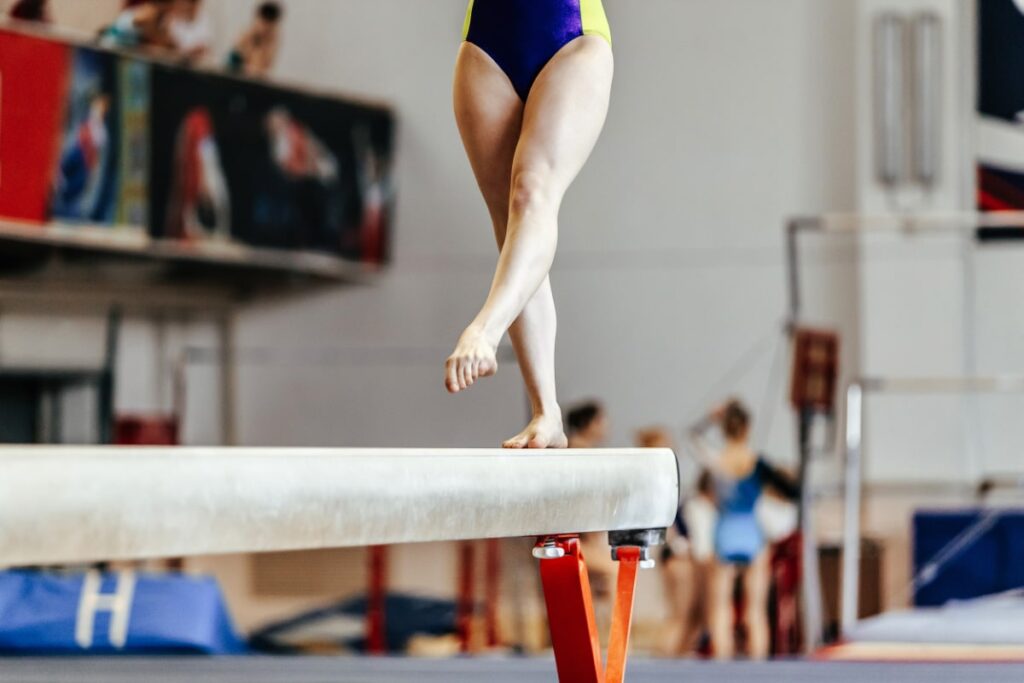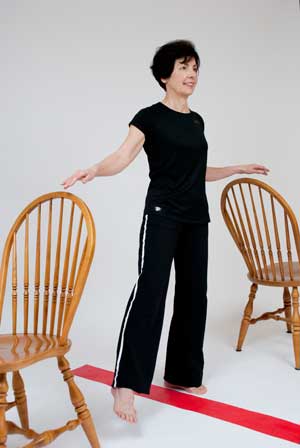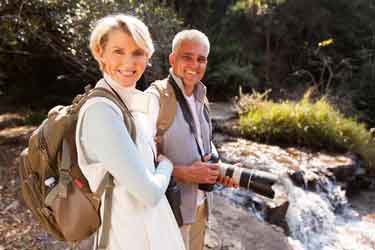Table of Contents
Standing on one leg requires not only balance but also strength in our upper and lower legs, hips and core muscles. In life, we step in multiple directions. The single leg balance exercise with movement helps us develop the strength and stability we need to safely step forward, backwards and to the side. The exercise is one of the balance exercises in Exercise for Better Bones Program.

Single Leg Balance Exercise with Movement
The single leg balance with movement is a progression from a static single leg balance exercise (also found in Exercise for Better Bones). The exercise is excellent for people of all ages who want to improve their balance and reduce their risk of fracture from osteoporosis.
Preparation for the Single Leg Balance Exercise with Movement
Before you start the single leg balance exercise with movement, take a moment to ensure you have your postural alignment in place to maximize your success with the exercise.
- Stand tall with your feet hip width apart. bring all of your attention to your feet.
- As you stand tall with soft knees, press your feet firmly into the ground.
- Encourage grounding from your feet evenly.
- Distribute your weight through the base of your big toe, your little toe and the centre of your heels.
- Next, take a full breath in through your nose or mouth.
- Exhale through your mouth.
- Relax your body while still maintaining your best posture.
- On your next breath, exhale gently through pursed lips.
- Become aware of the gentle tightening of your pelvic floor and deep abdominals as you exhale.
- Continue to breathe in a relaxed manner and observe if you are able to maintain a soft engagement of your deep abdominal muscles while you take your next 5 breaths.
You are now ready to progress to the exercise. Maintain this new awareness and take it with you into the single leg balance exercise with movement.
Step by Step Instructions for the Single Leg Balance Exercise with Movement
Follow these steps to ensure you safely do this exercise:
- Stand in between two strong chairs or between your kitchen counter and the wall, if you have a narrow galley kitchen.
- Keep your hands just above the chairs.
- As with all of the standing exercises, keep a soft bend in your knees.
- Stand in your best upright posture.
- Take a breath in.
- Exhale through pursed lips as you slowly begin transferring your weight onto your left foot.
- For the remainder of the exercise keep your breath soft and easy.
- Inhale as you bring your leg by your side.
- Ensure that you feel stable before you progress to moving the opposite leg.
- Slowly lift your right foot in front of you as though you are kicking a soccer ball.
- Return your foot to rest beside the left but off the floor.
- Then slowly bring your right out to your side.
- Return your foot to rest beside the left but off the floor.
- Next, slowly bring your right heel behind you.
- Return your foot to rest beside the left but off the floor.
- Repeat this entire sequence on your right foot.
Variations of the Single Leg Balance Exercise with Movement
You can easily add variety (and challenges) to this exercise. Here are several ways to modify the single leg balance exercise with movement to make it more interesting and challenging. Consider varying the following while you maintain your stance:
- The position of your arms.
- Add movements of your eyes.
- Add movements of your head.
Also consider varying the surface you are standing on while doing the exercise.

Exercise Recommendations for Osteoporosis
Exercise is an essential ingredient to bone health. If you have osteoporosis, therapeutic exercise needs to be part of your osteoporosis treatment program.
But what exercises should you do and which ones should you avoid? What exercises build bone and which ones reduce your chance of a fracture? Is Yoga good for your bones? Who should you trust when it comes to exercises for osteoporosis?
A great resource on exercise and osteoporosis is my free, seven day email course called Exercise Recommendations for Osteoporosis. After you provide your email address, you will receive seven consecutive online educational videos on bone health — one lesson each day. You can look at the videos at anytime and as often as you like.

I cover important topics related to osteoporosis exercise including:
- Can exercise reverse osteoporosis?
- Stop the stoop — how to avoid kyphosis and rounded shoulders.
- Key components of an osteoporosis exercise program.
- Key principles of bone building.
- Exercises you should avoid if you have osteoporosis.
- Yoga and osteoporosis — should you practice yoga if you have osteoporosis?
- Core strength and osteoporosis — why is core strength important if you have osteoporosis?
Enter your email address and I will start you on this free course. I do not SPAM or share your email address (or any information) with third parties. You can unsubscribe from my mail list at any time.

Comments
March 3, 2011 at 11:54am
Anne Pringle Burnell
So glad you included safety precautions such as a mat and TWO sturdy chairs.
So many videos dealing with seniors health and fitness use folding chairs!
Thanks for sharing. Keep up the great work.
Stay Strong,
Anne Burnell
March 4, 2011 at 3:14pm
Margaret Martin replies
Hi Anne, Thank you for your kind comments. I like your energy and guidance in your videos. We seem to have a similar passion.
October 1, 2019 at 1:25pm
carrie
Is it safe to move your leg out to the side? I thought I had read otherwise, but maybe I missed something!
October 2, 2019 at 8:43pm
Margaret Martin replies
Hi Carrie,
While doing any of the movements your goal is to maintain good alignment in your supporting knee and your pelvis. Safe alignment is important if I did not stress it enough, thank you for reminding us all. Beginning with the single leg stance and no additional movement, then progresssing to adding movement while using a little support and then gradually eliminating the support as long as you maintain the alignment.
Margaret